DISCLAIMER – I’m going to keep this post anonymous as it is in no way intended to be a dig at anybody but it is based on a true story from a photoshoot I undertook recently. The reason for writing this post is simply to highlight the real costs involved in working for free. I’ve underaken a number of free jobs over the
Very recently I agreed to cover a show in a London theatre as a freebie or nil-paid job. TFP or TFCD as it is sometimes known in the industry. I entered into this fully aware I’d be doing it for free. Why? Because theatre presented a gap in my portfolio. This was a gap I wanted to fill and the experience I would gain from it coupled with the networking opportunities far outweighed any potential loss in revenue. So, why am I writing this post? Well, the primary reason is to highlight what the real cost is of undertaking free work whilst leaving aside any discussion on the loss of revenue. As an interesting comparison I’m going to compare this to my standard wedding package.On face value there is the physical expense of such a job such as the cost of travel to get to the shoot. With rising full costs and price increases on public transport I’m now faced with a bill in excess of £25 every time I work in Central London. This is small beer though when compared to the other, hidden costs, namely the time involved. This is not insignificant and when one looks at it in detail it really becomes quite startling.
Prep-time…
Every photo-shoot, no matter how big or small or important needs prep time. This will very considerably depending on what the brief is. At the bottom of the scale is the equipment cleaning, card formatting and battery charging that accompanies every job together with packing the kit bag. This is at least a couple of hours work, right off the bat. Battery charging alone needs to start two days before the shoot if it will all be done using speedlites.
For bigger jobs there is also location scouting which in itself can dake days, researching ideas and preparation of a mood board, building and briefing a prep team, costing, styling and all manner of planning. It all consumes time, whether billed or unbilled.
Luckily for my theatre job that I’m basing this post on the prep time was around 2 hours work.
For a typical weding this element is quite large as it covers the client consultations, pre-wedding shoot and visits to the venues. 2.5 days work is not unreasonable here
Doing the shoot…
This is the element that is most visible to the client – the turning up and fiddling with the camera bit and capturing the images.
My theatre job was a full 7 hours on site compared to a full 12 hours for my wedding work.
The invisible element here is the travel time. This will easily be 1.5 hours for a job in Central London and for most weddings last year it was about an hour’s drive to get there and about 30 minutes from the Church to the reception venue.
This brings the theatre job up to 10 hours which is still short of the 14.5 hours I would spend doing a wedding.
Proofing
This is another invisible chunk of time and will vary greatly on the number of images captured during the shoot. I’ve spent a lot of time improving my workflow over the last three years and even so it can still take a lot of time to get to the proofing stage. Uploading and backing up the images from the cards is a relatively slow process and this is dwarfed by the time it takes to sub edit the images I’m happy to put forwards for proofing. Which ever way you slice it, it takes time to go through all the images. A wedding or studio fashion shoot can easily gross 2,000 images! For my theatre job I didn’t have anything like that number, thankfully.
After the sub edit to select the proof images I always do a quick (and I do mean quick!) preliminary retouch in Lightroom prior to generating the proofs. This is normally about a minute or two max. per proof image to get the colour temperature in the right ball park and a very minor exposure adjustment. Any more than that would be sheer folly and the only reason I go though this now is by virtue of Lightroom’s ability to synchronise develop settings across images.
My theatre job consumed about 12 hours work to get the images to the proofing stage. Compare this to a wedding will very often be three or four days work, including building an online proofing gallery.
Retouching
I try and subscribe to getting as much right in the camera rather than relying on post processing. Nevertheless, some degree of post will always be required to bring out the best in the image. My retouch tends to be very light in nature and as a rule of thumb I use 30 minutes as a good starting point and modify this up or down accordingly. Studio work usually needs less work unless it’s a beauty shoot. Location work generally needs more. Sometimes a lot more. Editorial work on the other hand gets absolutely none.
For the theatre, the stage and curtains needed a lot of work. If I’m honest, significantly more than I had ever expected. Being a live lighting environment meant that each frame the client selected needed to be colour balanced and have its exposure adjusted individually resulting in about 1.5 hours per image and in one case as much as 2 hours. The client’s initial selection of 40 images would have resulted in over two weeks work so on this occasion I had to push back and limit them to 10. Even so it was significantly more work than I had anticipated based on my previous experience and although I did it all in a single day, it was a very long day’s work to grind through them.
Compare that to one of my weddings… My premier package includes up to 60 images as standard for the Bride’s and Groom’s album and I usually expect to complete the retouch and get the first iteration of the album designed within about 60 hours.
Client/Team Communication
Another often overlooked and underestimated element of any job is the sime spent communicating with the client both before and after the shoot. All those telephone calls, emails, messages etc. all take time to read, digest and answer
Theatre job – probably about half a day’s worth of communication
Wedding job – probably about a day in total
Summary…
In the table below I’ve pulled out the time taken for each of the major work items I’ve discussed during this post. The important thing about all this is to understand that the actual photography part of the job is only a small per centage of the whole activity. Most clients will be blissfully unaware of just how much work goes into each set of finals I deliver to my clients. And so they should be. They don’t need to know that their wedding images are going to take a week and a half to get into an album, not do they need to know that it takes me a long time to back up and archive their images. All they really need to know is that I’ve taken the photographs and they will get their choice of the images I make available to them.
| Item | Theatre | Wedding |
|---|---|---|
| Preparation | 2.00hrs | 20.00hrs |
| Doing the job | 10.00hrs | 14.00hrs |
| Proofing | 12.00hrs | 28.00hrs |
| Retouch | 16.00hrs | 60.00hrs |
| Client Communication | 4.00hrs | 8.00hrs |
| Total | 44.00hrs | 130.00hrs |
One observation I have made over the years though is the perceived value of an image. When a client is paying me to produce work for them there is an intrinsic value attached to each image because I charge by the image. This in turn means that they are much more judicious when making their final selection. There is real money, hard cash, associated with their choice.
Free jobs on the other hand have absolutely no intrinsic value associated with the image. No money changes hands and the client is completely unaware of the amount of work involved in producing that body of work. As such there is a very predictable characteristic with TFP work insofar as the client will always request more images because they are unaware of the costs to me. After all, its a digital image so we can just get a JPG off the camera and that’s it. If only life were that simple 🙂
There is another cost involved too. One that is particularly painful to me running a business. That of giving up invoicable time to work on a free job. Now I did mention at the very beginning of this post that I was not going to mention lost revenue from doing free work but upon reflection there is a very real danger here – that of prioritising nil-cost jobs over revenue generating work. My view is a simple one and I do remind my clients of this. If I do undertake to do a free job (albeit very rare these days) I will always prioritise revenue generating work over and above theirs. It simply cannot be any other way. For me, the most important factor is earning money to feed my family. I do this through selling my images. If I undertook a free job, spent a week working on it and didn’t earn any money that week my family wouldn’t eat. Somehow I don’t think a hungry 5yo with a print credit would appreciate a print credit.
The Golden Rule…
This now begs the question “would I undertake more free work?”
There is only one answer to this – “that depends”
It depends on whether I can see the job adding something to my portfolio. By that I mean will I be generating images that will replace something already there or will I be generating images that plug a gap?
I still test with model agencies and creatives. I still test when there is a very strong concept behind a shoot or its something I’d really like to do. I still test when I can plug a gap.
The golden rule is a simple one: “What will this job add to my portfolio that is better than my current offering?



[…] gavin on Apr.04, 2011, under Journey, Musings After writing yesterday’s post on the true cost (to me) of a free job, I feel inspired to follow up with this one based on a telephone conversation I had this afternoon. […]